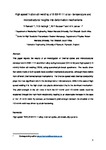High Speed Friction Stir Welding of 5182-H111 Alloy: Temperature and Microstructural Insights into Deformation Mechanisms
| dc.contributor.author | Bernard, D | |
| dc.contributor.author | Hattingh, DG | |
| dc.contributor.author | Goosen, WE | |
| dc.contributor.author | James, Neil | |
| dc.date.accessioned | 2020-02-24T08:51:03Z | |
| dc.date.available | 2020-02-24T08:51:03Z | |
| dc.date.issued | 2021-08 | |
| dc.identifier.issn | 1598-9623 | |
| dc.identifier.issn | 2005-4149 | |
| dc.identifier.uri | http://hdl.handle.net/10026.1/15397 | |
| dc.description.abstract |
This paper reports the results of an investigation of thermal cycles and microstructural development in 5182-H111 aluminium alloy during low speed (0.2 m/min) and high speed (1.5 m/min) friction stir welding (FSW), using quenched pin-break specimens. The results show that welds made at both speeds have excellent mechanical properties, although these derive from different thermomechanical mechanisms. For the low speed weld thermal conductivity plays the most significant role in the development of microstructure, while in the case of high speed welding it is the high strain rate plastic deformation that is the dominant mechanism. The yield strength in the stir zone of both the 0.2 m/min and 1.5 m/min welds could be explained through the Hall–Petch relationship, leading to an observable increase in the case of the 1.5 m/min weld. By contrast, an increase in yield strength beneath the shoulder of the 1.5 m/min weld was driven by strain hardening. | |
| dc.format.extent | 2821-2836 | |
| dc.language | en | |
| dc.language.iso | en | |
| dc.publisher | Springer Science and Business Media LLC | |
| dc.subject | High speed FSW | |
| dc.subject | 5182-H111 alloy | |
| dc.subject | Thermal cycles | |
| dc.subject | Pin-break | |
| dc.subject | Slip systems | |
| dc.title | High Speed Friction Stir Welding of 5182-H111 Alloy: Temperature and Microstructural Insights into Deformation Mechanisms | |
| dc.type | journal-article | |
| dc.type | Journal Article | |
| plymouth.author-url | https://www.webofscience.com/api/gateway?GWVersion=2&SrcApp=PARTNER_APP&SrcAuth=LinksAMR&KeyUT=WOS:000518115000001&DestLinkType=FullRecord&DestApp=ALL_WOS&UsrCustomerID=11bb513d99f797142bcfeffcc58ea008 | |
| plymouth.issue | 8 | |
| plymouth.volume | 27 | |
| plymouth.publication-status | Published | |
| plymouth.journal | Metals and Materials International | |
| dc.identifier.doi | 10.1007/s12540-020-00622-y | |
| plymouth.organisational-group | /Plymouth | |
| plymouth.organisational-group | /Plymouth/Faculty of Science and Engineering | |
| plymouth.organisational-group | /Plymouth/Faculty of Science and Engineering/School of Engineering, Computing and Mathematics | |
| plymouth.organisational-group | /Plymouth/Users by role | |
| plymouth.organisational-group | /Plymouth/Users by role/Academics | |
| dcterms.dateAccepted | 2020-01-16 | |
| dc.rights.embargodate | 2021-1-30 | |
| dc.identifier.eissn | 2005-4149 | |
| dc.rights.embargoperiod | Not known | |
| rioxxterms.versionofrecord | 10.1007/s12540-020-00622-y | |
| rioxxterms.licenseref.uri | http://www.rioxx.net/licenses/all-rights-reserved | |
| rioxxterms.type | Journal Article/Review |


